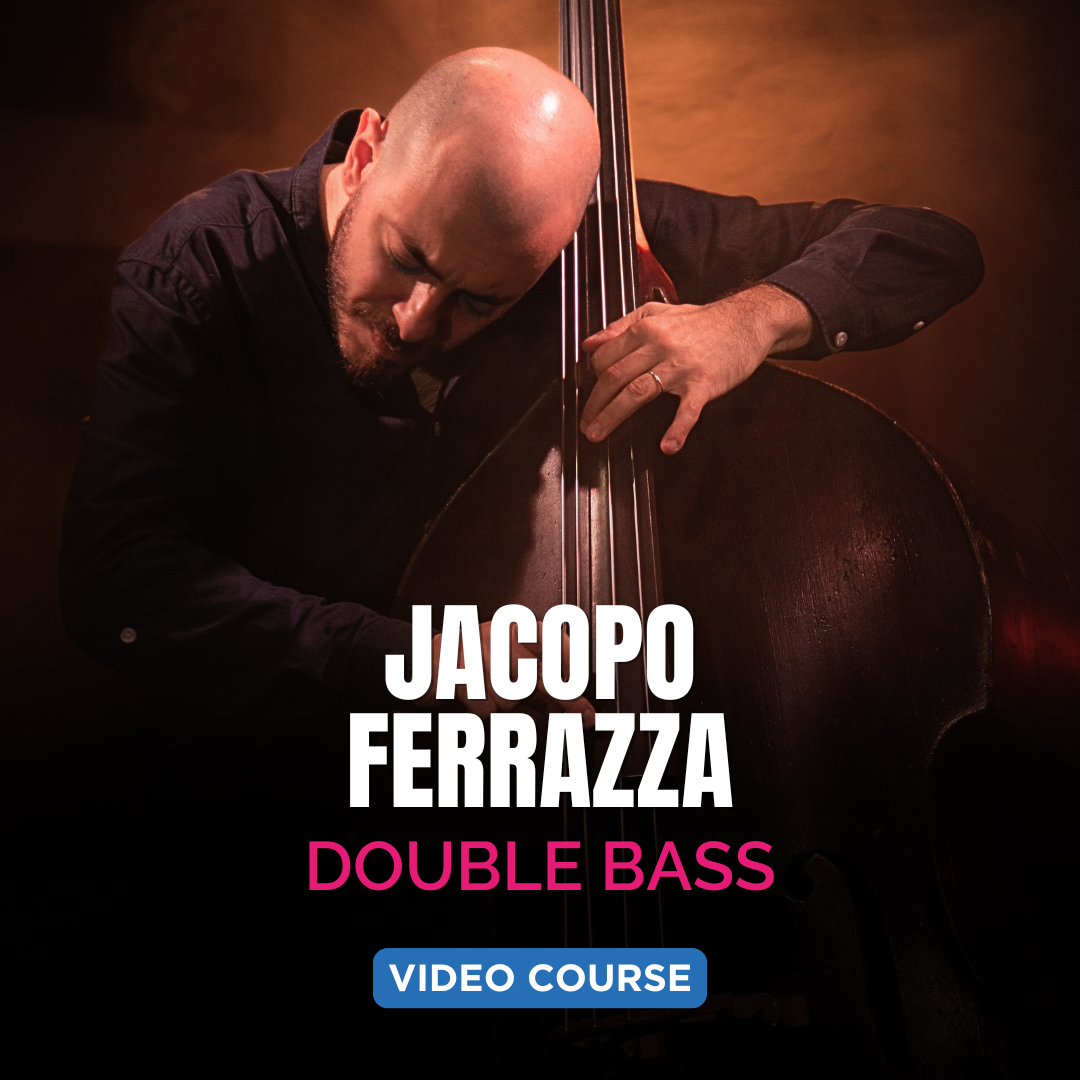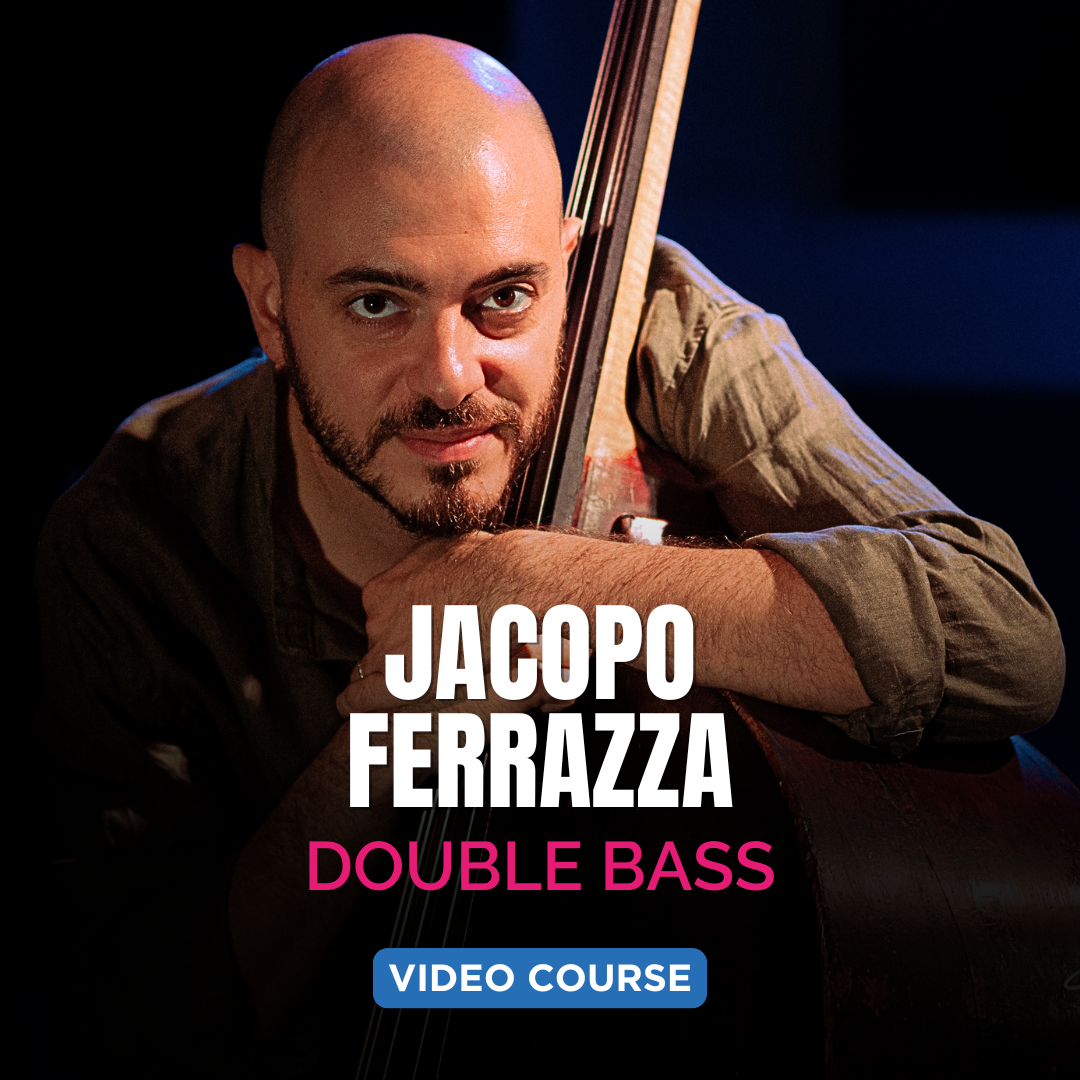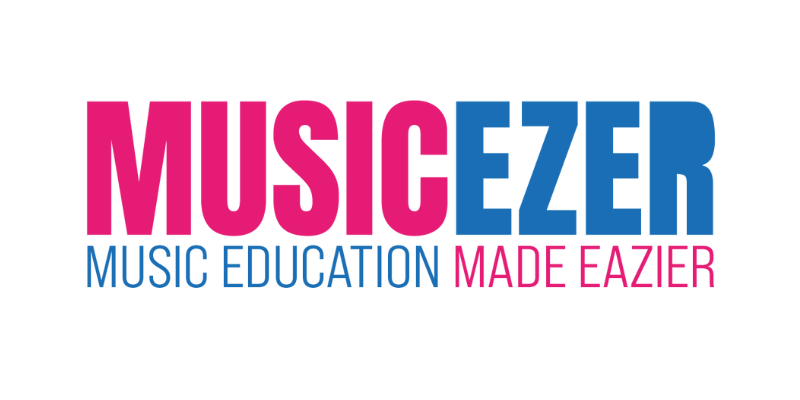DOUBLE BASS MASTERY
From the very basics to your first solo
with Jacopo Ferrazza
Course with subtitles available in
🇮🇹 🇺🇸


The course will be available online from November 20, 2025.
Discover the complete path to mastering the double bass: from the very first notes and posture, to walking bass lines, harmony applied on the instrument, and finally your own improvised solo.
This course guides you step by step through technique, groove, and sound production — combining pizzicato, bowing, scales, arpeggios, and timing — until you can confidently create and perform.
Whether you are a beginner just starting out, or an intermediate player looking to develop your jazz language, you’ll gain the skills to unlock the full expressive potential of the double bass.

COURSE DETAILS
The course aims to offer a comprehensive and progressive training program for those who wish to study the double bass seriously and consciously. It is designed for both beginners who wish to build a solid technical and musical foundation, and for intermediate musicians who wish to deepen their use of harmony and improvisation on the instrument.
The program clearly and gradually addresses all the fundamental aspects of studying the double bass: from the positioning of the body , arms, hands, and legs , to the application of harmony through the study of walking bass and improvisation . Each topic is linked to practical exercises, for a learning experience that combines technique and musicality .
The course also includes in-depth studies on double bass amplification and the use of the bow , fundamental elements for obtaining a correct sound and for developing full mastery of the keyboard.
The course concludes with a lesson dedicated to the construction of a solo , in which the student can put into practice everything he has learned - from technique to harmonic awareness - creating a complete musical synthesis of his study .
The course will be online by 20/11/2025
START NOWWe will analyze how the instrument is built, how it is tuned, how it is amplified and the correct posture to play effortlessly and achieve the best results.
Here we will analyze the setting of the two hands, the correct position of both thumbs and the various positions and variations.
In this important chapter we will deepen our knowledge of the keyboard and its division into tones and semitones, the basic positions, the most useful exercises for memorizing movements and jumps through the "chessboard" technique and improving intonation.
In this chapter, we'll address what's known as every bassist's "bête noire": the capo. We'll try to simplify the approach and facilitate the exploration of this second half of the instrument, which often poses a major obstacle and often risks remaining unexplored.
In this chapter, we'll begin to explore the main scales and their corresponding chordal arpeggios in horizontal and vertical positions on the instrument. This will help us create a technical/harmonic foundation for the study of the following chapters.
The bow is a fundamental tool for deepening your knowledge of the instrument and in this chapter we will understand how to approach it, which technique to use, the bowing and the basic exercises for correct intonation.
In this lesson, we'll begin to explore walking, a fundamental element of jazz double bass and beyond. We'll learn how to build a walking bass line starting with chordal notes and then move on to more complex lines.
In this second chapter on walking, we will continue the discussion we began with chordal notes by introducing scalar and chromatic approaches, arriving at constructing more complex and harmonically and melodically more effective lines.
Timing is one of the most important elements for a bassist, and in this chapter we'll explore how to improve it and explore various approaches to tempo in walking and soloing. We'll use the metronome in different ways and understand how to get the most out of it.
In this chapter, we'll build on the technical/harmonic concepts outlined in the previous chapters to begin constructing an effective and melodically sound solo. We'll understand how reintroducing rhythmic-melodic elements can be crucial in creating an effective solo.
Continuiamo a vedere come riutilizzare il materiale ritmico/melodico può aiutarci nel costruire un solo coerente con la struttura e con un’identità melodica stabile.
COURSE EXTRACTS
COURSES ON MUSICEZER
95%
User satisfaction level
87%
Course completion level
STRENGTHS
An educational video path in 4K and HD audio , the complete booklet with all the transcriptions of the musical parts analyzed and played by Jacopo Ferrazza .

♾️ THE COURSE IS YOURS FOREVER

🎧 LIKE IN THE FRONT ROW

🎓 LEARN FROM THOSE WHO REALLY PLAY

JACOPO FERRAZZA
Jacopo Ferrazza was born in 1989 in Frascati, near Rome. Considered one of Europe's most promising double bass players/composers, he began studying guitar at 8, piano at 12, electric bass at 14, and double bass at 18.
In 2018 he won the SIAE award for best Italian talent and has been ranked among the top 3 talents several times by Musica Jazz magazine.
He studied bass and double bass with his father Angelo, John Patitucci, Aldo Perris and Ares Tavolazzi and graduated in classical double bass with Maestro Luca Cola at the Frosinone Conservatory in 2015. He also graduated in classical piano with Maestro Carlo Negroni in 2016.
Jacopo has performed at major national festivals and at foreign festivals and clubs in Germany, New York, Illinois, Washington, Morocco, South Korea, Finland, Turkey, Poland, Japan, Switzerland, Spain, China, Czech Republic, North Carolina, Belarus, Albania, Kosovo, Holland, Croatia, Zambia, Zimbabwe, Bulgaria and Israel.
Over the years he has collaborated with important international artists such as: Dave Liebman, Fabrizio Bosso, Nicola Piovani, Enrico Rava, George Garzone, Enrico Pieranunzi, Jane Monheit, Dayna Stephens, Greg Hutchinson, Camille Bertault, Paolo Fresu, Rita Payes, Maurizio Giammarco, Philip Dizack, Logan Richardson, Nico Gori, Javier Girotto, Rosario Giuliani, Roberto Gatto, Rita Marcotulli, Mario Biondi, Max Ionata and many others.
He has recorded over 40 albums as a sideman and 5 as a leader: “Rebirth” (2017) and “Theater” (2019) for Cam Jazz and “Wood Tales” (2021), 'Fantàsia' (2022), “Prometheus” (2025) for his own label Teal Dreamers Factory.
Since 2019 he has been a conservatory teacher and since 2022 a jazz ensemble teacher at the “Licinio Refice” Conservatory in Frosinone.
STUDY WITH THE MASTERBUT HOW MUCH DOES IT COST ME?
Accessible to everyone at a fraction of its real value!

